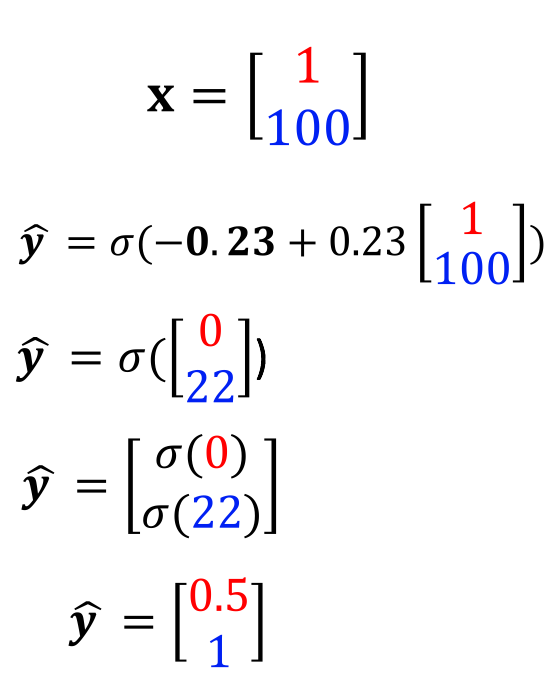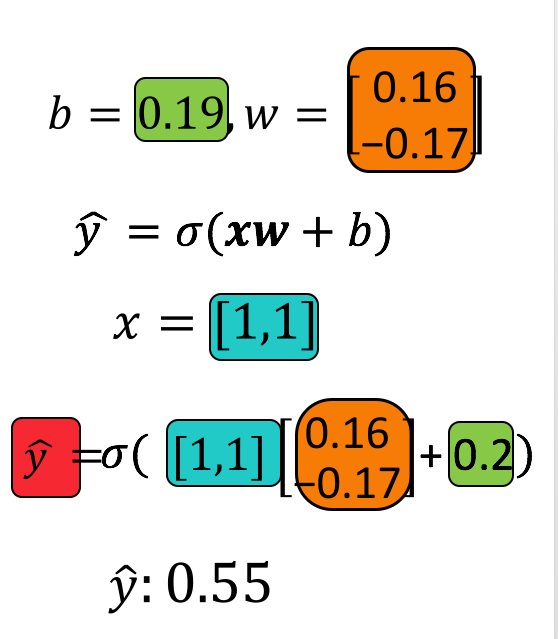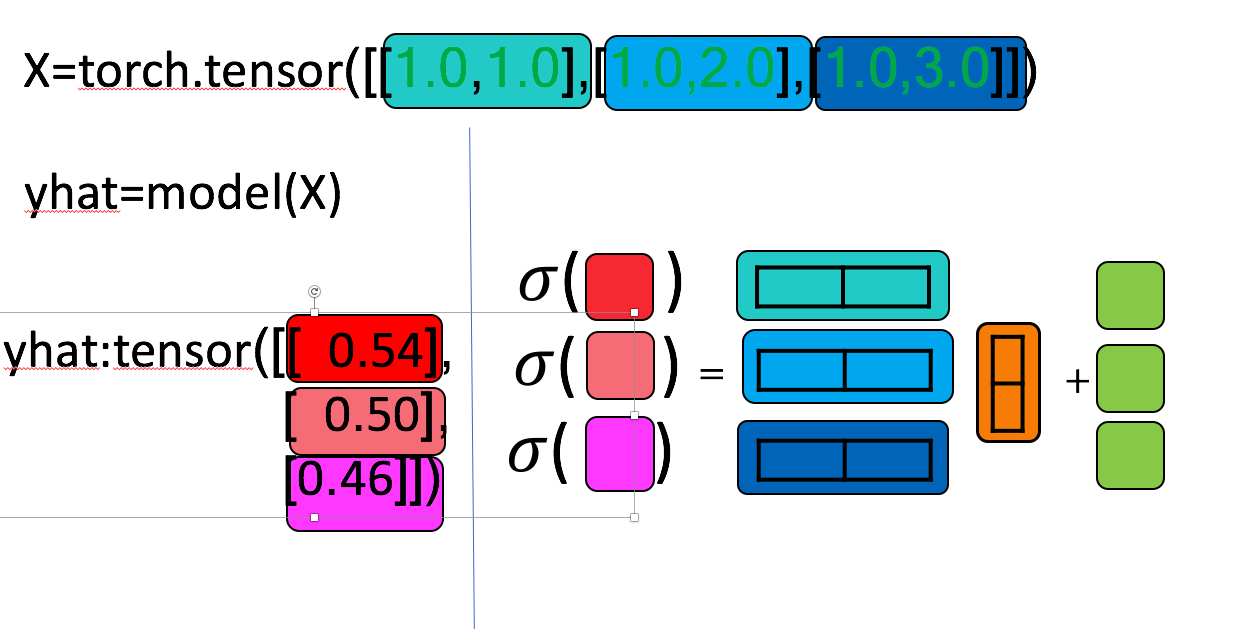# Import the libraries we need for this lab
import torch.nn as nn
import torch
import matplotlib.pyplot as pltLogistic Regression
Training Two Parameter, Mini-Batch Gradient Decent, Training Two Parameter Mini-Batch Gradient Decent

Objective
- How to create a logistic regression object with the nn.Sequential model.
Table of Contents
In this lab, we will cover logistic regression using PyTorch.
Estimated Time Needed: 15 min
Preparation
We’ll need the following libraries:
Set the random seed:
# Set the random seed
torch.manual_seed(2)<torch._C.Generator at 0x714cbc14af50>Logistic Function
Create a tensor ranging from -100 to 100:
z = torch.arange(-100, 100, 0.1).view(-1, 1)
print("The tensor: ", z)The tensor: tensor([[-100.0000],
[ -99.9000],
[ -99.8000],
...,
[ 99.7000],
[ 99.8000],
[ 99.9000]])Create a sigmoid object:
# Create sigmoid object
sig = nn.Sigmoid()Apply the element-wise function Sigmoid with the object:
# Use sigmoid object to calculate the
yhat = sig(z)Plot the results:
plt.plot(z.numpy(), yhat.numpy())
plt.xlabel('z')
plt.ylabel('yhat')Text(0, 0.5, 'yhat')
Apply the element-wise Sigmoid from the function module and plot the results:
yhat = torch.sigmoid(z)
plt.plot(z.numpy(), yhat.numpy())
Build a Logistic Regression with nn.Sequential
Create a 1x1 tensor where x represents one data sample with one dimension, and 2x1 tensor X represents two data samples of one dimension:
# Create x and X tensor
x = torch.tensor([[1.0]])
X = torch.tensor([[1.0], [100]])
print('x = ', x)
print('X = ', X)x = tensor([[1.]])
X = tensor([[ 1.],
[100.]])Create a logistic regression object with the nn.Sequential model with a one-dimensional input:
# Use sequential function to create model
model = nn.Sequential(nn.Linear(1, 1), nn.Sigmoid())The object is represented in the following diagram:

In this case, the parameters are randomly initialized. You can view them the following ways:
# Print the parameters
print("list(model.parameters()):\n ", list(model.parameters()))
print("\nmodel.state_dict():\n ", model.state_dict())list(model.parameters()):
[Parameter containing:
tensor([[-0.5717, 0.1614]], requires_grad=True), Parameter containing:
tensor([-0.6260], requires_grad=True)]
model.state_dict():
OrderedDict({'linear.weight': tensor([[-0.5717, 0.1614]]), 'linear.bias': tensor([-0.6260])})Make a prediction with one sample:
# The prediction for x
yhat = model(x)
print("The prediction: ", yhat)The prediction: tensor([[0.2943]], grad_fn=<SigmoidBackward0>)Calling the object with tensor X performed the following operation (code values may not be the same as the diagrams value depending on the version of PyTorch) :

Make a prediction with multiple samples:
# The prediction for X
yhat = model(X)
yhattensor([[0.4979],
[1.0000]], grad_fn=<SigmoidBackward0>)Calling the object performed the following operation:
Create a 1x2 tensor where x represents one data sample with one dimension, and 2x3 tensor X represents one data sample of two dimensions:
# Create and print samples
x = torch.tensor([[1.0, 1.0]])
X = torch.tensor([[1.0, 1.0], [1.0, 2.0], [1.0, 3.0]])
print('x = ', x)
print('X = ', X)x = tensor([[1., 1.]])
X = tensor([[1., 1.],
[1., 2.],
[1., 3.]])Create a logistic regression object with the nn.Sequential model with a two-dimensional input:
# Create new model using nn.sequential()
model = nn.Sequential(nn.Linear(2, 1), nn.Sigmoid())The object will apply the Sigmoid function to the output of the linear function as shown in the following diagram:

In this case, the parameters are randomly initialized. You can view them the following ways:
# Print the parameters
print("list(model.parameters()):\n ", list(model.parameters()))
print("\nmodel.state_dict():\n ", model.state_dict())list(model.parameters()):
[Parameter containing:
tensor([[ 0.1939, -0.0361]], requires_grad=True), Parameter containing:
tensor([0.3021], requires_grad=True)]
model.state_dict():
OrderedDict({'0.weight': tensor([[ 0.1939, -0.0361]]), '0.bias': tensor([0.3021])})Make a prediction with one sample:
# Make the prediction of x
yhat = model(x)
print("The prediction: ", yhat)The prediction: tensor([[0.6130]], grad_fn=<SigmoidBackward0>)The operation is represented in the following diagram:

Make a prediction with multiple samples:
# The prediction of X
yhat = model(X)
print("The prediction: ", yhat)The prediction: tensor([[0.6130],
[0.6044],
[0.5957]], grad_fn=<SigmoidBackward0>)The operation is represented in the following diagram:

Build Custom Modules
In this section, you will build a custom Module or class. The model or object function is identical to using nn.Sequential.
Create a logistic regression custom module:
# Create logistic_regression custom class
class logistic_regression(nn.Module):
# Constructor
def __init__(self, n_inputs):
super(logistic_regression, self).__init__()
self.linear = nn.Linear(n_inputs, 1)
# Prediction
def forward(self, x):
yhat = torch.sigmoid(self.linear(x))
return yhatCreate a 1x1 tensor where x represents one data sample with one dimension, and 3x1 tensor where \(X\) represents one data sample of one dimension:
# Create x and X tensor
x = torch.tensor([[1.0]])
X = torch.tensor([[-100], [0], [100.0]])
print('x = ', x)
print('X = ', X)x = tensor([[1.]])
X = tensor([[-100.],
[ 0.],
[ 100.]])Create a model to predict one dimension:
# Create logistic regression model
model = logistic_regression(1)In this case, the parameters are randomly initialized. You can view them the following ways:
# Print parameters
print("list(model.parameters()):\n ", list(model.parameters()))
print("\nmodel.state_dict():\n ", model.state_dict())list(model.parameters()):
[Parameter containing:
tensor([[0.2381]], requires_grad=True), Parameter containing:
tensor([-0.1149], requires_grad=True)]
model.state_dict():
OrderedDict({'linear.weight': tensor([[0.2381]]), 'linear.bias': tensor([-0.1149])})Make a prediction with one sample:
# Make the prediction of x
yhat = model(x)
print("The prediction result: \n", yhat)The prediction result:
tensor([[0.5307]], grad_fn=<SigmoidBackward0>)Make a prediction with multiple samples:
# Make the prediction of X
yhat = model(X)
print("The prediction result: \n", yhat)The prediction result:
tensor([[4.0805e-11],
[4.7130e-01],
[1.0000e+00]], grad_fn=<SigmoidBackward0>)Create a logistic regression object with a function with two inputs:
# Create logistic regression model
model = logistic_regression(2)Create a 1x2 tensor where x represents one data sample with one dimension, and 3x2 tensor X represents one data sample of one dimension:
# Create x and X tensor
x = torch.tensor([[1.0, 2.0]])
X = torch.tensor([[100, -100], [0.0, 0.0], [-100, 100]])
print('x = ', x)
print('X = ', X)x = tensor([[1., 2.]])
X = tensor([[ 100., -100.],
[ 0., 0.],
[-100., 100.]])Make a prediction with one sample:
# Make the prediction of x
yhat = model(x)
print("The prediction result: \n", yhat)The prediction result:
tensor([[0.2943]], grad_fn=<SigmoidBackward0>)Make a prediction with multiple samples:
# Make the prediction of X
yhat = model(X)
print("The prediction result: \n", yhat)The prediction result:
tensor([[7.7529e-33],
[3.4841e-01],
[1.0000e+00]], grad_fn=<SigmoidBackward0>)Practice
Make your own model my_model as applying linear regression first and then logistic regression using nn.Sequential(). Print out your prediction.
# Practice: Make your model and make the prediction
X = torch.tensor([-10.0])
my_model = nn.Sequential(nn.Linear(1, 1), nn.Sigmoid())
my_model(X)tensor([0.2231], grad_fn=<SigmoidBackward0>)Double-click here for the solution.
Back to top